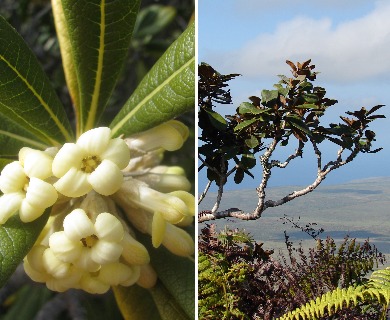Hōʻawa
Pittosporum confertiflorum
Cheesewoods family (Pittosporaceae)
Native species (); some introduced
This variable species is an example of its which has about 10 Hawaiian species known as hō‘awa, also two naturalized species. Small shrubs or trees with large narrow leathery leaves on stout twigs, many small whitish flowers crowded at the base of leaves, and large rounded or four-angled deeply wrinkled that split open into two parts.

©2014 Forest And Kim Starr
Leaves many crowded near the end of erect twigs, with stout light yellow leaf-stalks of 3⁄8–2 inches (1–5 ). Blades to oblong, mostly 2 1⁄4–4 inches (6–10 ) long and 1–1 1⁄2 inches (2.5–4 ) wide, the largest to 8 inches (20 ) by 4 inches (10 ), thick, stiff, blunt at widest beyond middle and gradually narrowed toward base, curved under at edges. Upper surface dull green, densely gray hairy when young, becoming nearly hairless, with sunken light yellow and network of prominently sunken veins; lower surface densely brown hairy, with raised veins.
Flower clusters (corymbose ) mostly at leaf bases, about 1 inch (2.5 ) long. Flowers many, fragrant, crowded on short brown hairy stalks, or male and female, about 3⁄8 inch (1 ) long, composed of cup-shaped five- brown hairy about 1⁄4 inch (6 ) long; white with cylindrical tube about 3⁄8 inch (10 ) long with five spreading 1⁄4 inch (6 ) long. Male flowers have 5 attached at the base of the tube and extending beyond. Female flowers have five minute nonfunctioning and a narrow with hairy slightly two- two-celled and containing many ovules, and slender
(seed capsules) usually single (sometimes 2–3), rounded or four-angled, 3⁄4–1 1⁄2 inches (2–4 ) long, brown, with point at hard and thick-walled, the surface finely hairy, rough, deeply wrinkled, splitting into two parts, one-celled, inner wall orange, resinous or mucilaginous within. Seeds are many, elliptical, flat, more than 1⁄4 inch (6 ) long, shiny black.
The most widespread and common species of this in Hawaii, occurring from dryland forests to moist forests at 600–7200 ft (183–2194 ).
Special areas
Haleakala, Volcanoes
Range
Oahu, Lanai, Maui, and Hawaii only
Other common name
hā‘awa
Botanical
Pittosporum cauliflorum Mann, P. cladanthum Sherff, P. confertiflorum Gray, P. halophiloides Sherff, P. halophilum Rock, P. lanaiense St. John
Rock (1913) observed that the trees in this are very variable and that it is difficult to render the exact limitation of each species. He found capsules of three different “species” on a single twig on the island of Lanai, where the is exceedingly well represented. As there are as many different forms as trees, one would be naming individual trees. Insect pollination is a factor, he concluded.
One native and a few introduced species are planted as ornamentals. In Hawaii, a home remedy was obtained from the pulp of the pounded Plants of another native species, Pittosporum hosmeri Rock, can be seen on the grounds of the Bishop Museum.







